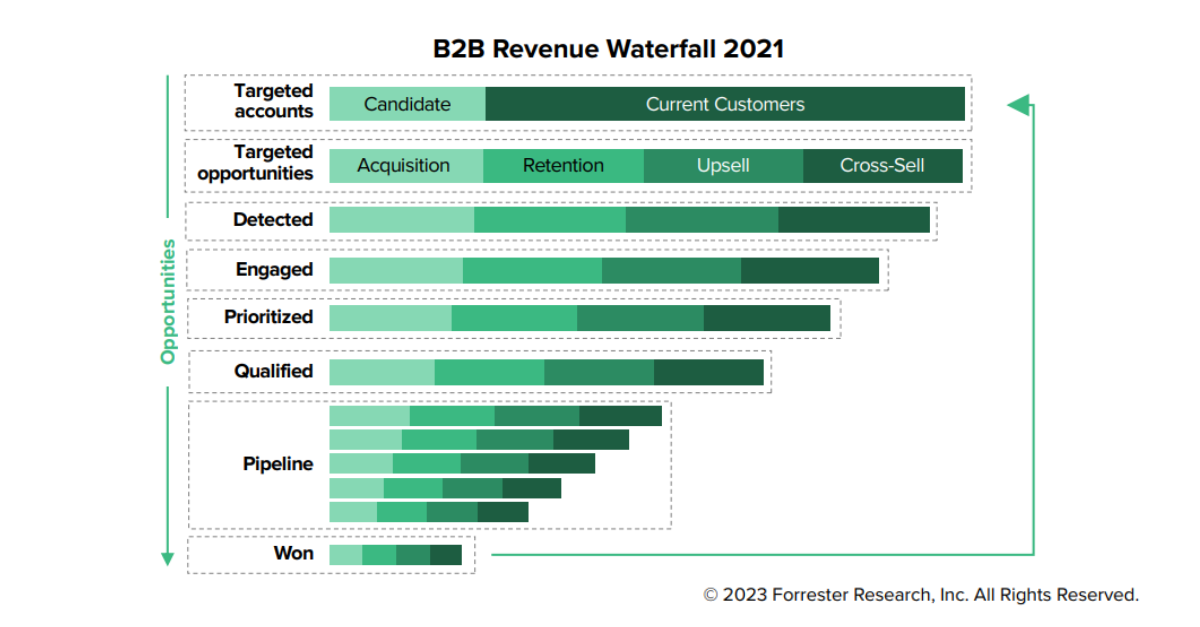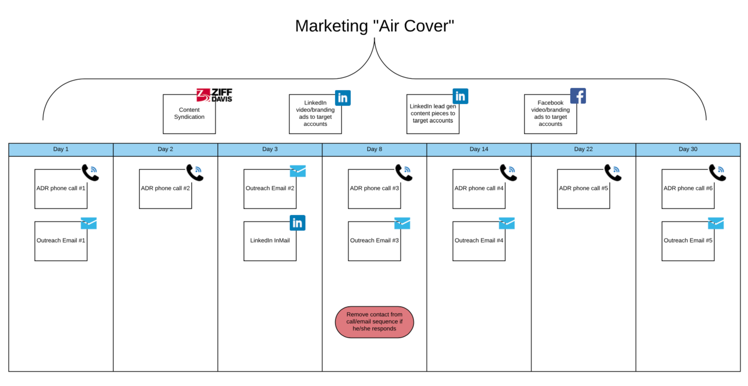
Nearly half of all leads passed to sales are qualified but not yet ready to make a purchase.
While this may signify misalignment between sales and marketing, the truth is, these leads aren’t bad—they simply need more time and the right approach. To win them over, sales and marketing need to work together to build trust, nurture relationships, and stay top of mind until the time is right.
That’s where lead nurturing comes in, a strategy used by marketing teams to guide prospects through the buying stage at their own pace while keeping your business top of mind.
Read on to learn how to identify these not-yet-ready leads and implement effective lead nurturing tactics that turn hesitation into confidence and “maybe later” into a definitive “yes.”
The Difference Between Lead Nurturing and Lead Generation
Lead nurturing focuses on building relationships with potential buyers who aren’t ready to purchase yet, providing them with valuable content and personalized communication to move them through every stage of the sales funnel. This involves strategies like:
- Sending personalized email campaigns
- Creating relevant and personalized content
- Using multichannel outreach methods
In contrast, lead generation is the process of attracting and identifying new prospects, to create a list of potential buyers. It’s more about sparking initial interest with prospects who may or may not be aware of your brand. This involves strategies like:
- Hosting events or webinars
- Running targeted ads to capture interest
- Using cold outreach like emails or calls
Ultimately, while lead generation sparks interest, lead nurturing turns that interest into a sale by guiding prospects toward a purchase decision.
Just How Much Nurturing Does a Lead Need?
When does your lead nurture program begin, and how long should it last? The answer might surprise you—it starts earlier than you think. In fact, effective nurturing begins before a prospect even interacts with your brand. You need to nurture leads even before you know who they are.
This idea is introduced in Forrester’s B2B Revenue Waterfall Waterfall:

In Forrester’s B2B Revenue Waterfall, the process starts with Targeted Accounts (current clients and potential clients that fit your ideal customer profile) and then moves to Targeted Opportunities (specific sales opportunities within those accounts, including acquisition, retention, upsell, and cross-sell).
As leads progress, they move through the stages of Detected, Engaged, Prioritized, and Qualified. However, many B2B companies mistakenly hand off leads to sales too soon, especially at the Engaged stage.
The Detected stage occurs before prospects even know they’re about to embark on a journey. Winning business in today’s marketplace means getting your message and content in front of them during this Detected stage, nurturing prospects before you they may even know you. Building trust and awareness early will lead to stronger B2B engagement and conversions later.
According to Gleanster Research, 50% of leads are qualified but not yet ready to buy, so it’s crucial to continue nurturing these leads throughout the funnel, all the way through the Pipeline and Win stages, to increase conversion chances.
How to Get Started with B2B Lead Nurturing Strategies
The power of a lead nurture strategy lies in its ability to build meaningful relationships with buyers at every stage of the funnel. By staying engaged throughout the buyer’s journey, marketers can keep leads moving forward, foster trust, and ultimately drive more B2B sales opportunities. In fact, marketers who implement lead nurturing strategies see an average 20% increase in sales opportunities compared to non-nurtured leads. Additionally, companies that excel at lead nurturing generate 50% more sales at 33% lower costs.
With such compelling results, investing in lead nurturing is a no-brainer. To help you get started, here is how to nurture leads in a few key steps that creates impactful campaigns and delivers measurable outcomes.
Identify Target Audience
Every successful lead nurturing campaign begins with a clear understanding of your target audience. Start by defining your ideal customer profiles (ICPs)—the companies that are the best fit for your products or services. Then, drill down further to develop detailed buyer personas, which represent the individuals within those companies who influence or make purchasing decisions.
When doing this, consider the following factors:
- Pain Points: What challenges are your prospects trying to solve?
- Goals: What are their primary objectives, and how can your product or service help achieve them?
- Buying Role: Are they a decision-maker, influencer, or end-user?
- Buyer Preferences: How do they prefer to receive and interact with content?
By identifying and understanding your audience, you can better create personalized messaging that resonates with their needs, ensuring that your nurturing efforts are relevant and impactful.
Create High-Value Content
Once you have an idea of your target audience, your content will be the backbone of your lead nurturing strategy. To effectively engage and nurture your prospects, it’s crucial to create high-value content tailored to their specific needs and stage in the buyer’s journey.
Start by identifying the key stages of the buyer’s journey and think about the existing content you have that speaks to each one:
- Awareness Stage: Prospects recognize a problem or need. Content should be educational and provide insights, such as blogs, landing pages, whitepapers, or industry reports.
- Consideration Stage: Prospects evaluate solutions. Offer comparative content, case studies, or webinars that highlight your product’s unique value.
- Decision Stage: Prospects are ready to make a choice. Provide demos, free trials, pricing guides, or ROI calculators to close the deal.
You should additionally tailor your content to the accounts you’re targeting, demonstrating that you understand their unique needs and challenges as well as their buying group‘s needs. You’ll want to think about both company insights, as well as buyer insights:
Company Insights
Reference the target account’s specific pain points, goals, or industry trends that are most relevant to them. For example, create customized reports or presentations that address the unique challenges their business is facing. Whether you’re targeting acquisition, upsell, or cross-sell opportunities, align your content with the account’s current needs. For new market entry, you might highlight how your product solves key business challenges. For cross-selling or upselling clients, focus on how additional products or features can enhance their existing solution and drive greater value.
Buyer Insights
You should also your content to appeal to the specific buyer you’re targeting within the account. For example, A CIO may prioritize technical specifications and product functionality, so providing detailed case studies or technical whitepapers would be most relevant. Meanwhile, a CMO may be more interested in ROI, customer success stories, or how your solution can enhance B2B marketing strategies. Tailoring content to the c-suite marketing role ensures that it speaks directly to their objectives and challenges.
High-value content marketing not only nurtures leads but also demonstrates your expertise, builds trust, and reinforces your brand’s position as the ideal solution provider—no matter the stage or type of opportunity.
Lead Validation and Scoring
Not all leads are created equal. To maximize impact and identify the leads that are actually ready to be passed off to sales, lead validation helps prioritize leads based on their engagement and fit with your ICP.
One way to do this is by assigning scores based on interactions (e.g., downloads, email opens, website visits) and how well a lead matches your ICP (industry, company size, etc.), you can identify which leads are most likely to convert. For example, a scoring or segmentation system might look like this:
- +10 points: Downloading a whitepaper
- +5 points: Opening an email
- +20 points: Requesting a demo
- +15 points: Attending a webinar
- +25 points: Matches ICP criteria (e.g., specific industry or company size)
It’s important to set clear thresholds for when a lead is ready to be passed to sales, such as a specific score (e.g., a score of 50 or higher) or actions like requesting a demo. For leads that aren’t yet ready, continue nurturing with targeted content. Regularly refine your scoring model based on sales feedback to improve its accuracy. This ensures you focus on high-potential leads and move them through the funnel efficiently.
Leverage Tools and Integrations
To streamline your lead nurturing efforts, leverage tools like email workflows, lead scoring, and behavior tracking to automate processes and ensure consistent, personalized follow-ups. These tools allow you to engage prospects efficiently and effectively throughout their buyer journey.
Here are some key tools to consider:
- CRM Platforms: Tools like HubSpot and Salesforce to manage and track leads.
- Marketing Automation Platforms: Solutions such as Marketo, HubSpot, and MailChimp for creating and automating campaigns.
- Lead Scoring: Prioritize leads based on engagement and readiness to purchase.
- Behavior Tracking: Monitor website visits, downloads, and interactions to tailor your outreach.
- ABM Tools: Focus on high-value accounts with personalized campaigns.
The most common way to engage with leads is through nurturing email, using platforms like Marketo, or MailChimp. For example, if you’ve recently launched a new product or feature, you can set up an email sequence to send updates to prospects every few days.
When a prospect takes an action—such as downloading an asset—you can trigger follow-up actions, like offering a demo or sharing a relevant case study. By integrating these tools and workflows, you can create a seamless and impactful lead nurturing strategy that moves prospects closer to conversion.
Align Marketing and Sales
Strong alignment between marketing and sales is essential for effective lead nurturing. By working together, both teams can ensure leads are nurtured effectively and passed to sales at the right time. Clear communication and shared goals allow for continuous improvement in nurturing strategies. Here are best practices for sales and marketing alignment resulting in lead nurturing success:
- Regular Check-Ins: Schedule regular meetings between marketing and sales to discuss lead quality, campaign performance, and any challenges in converting leads.
- Shared Definitions: Agree on what constitutes a “sales-ready” lead and when leads should transition from marketing to sales. This ensures that leads are nurtured until they are ready for B2B buyer personalized sales outreach.
- Feedback Loops: Implement a system for sales to provide input on the leads they receive, such as whether they were engaged, qualified, or needed further nurturing. This helps marketing fine-tune scoring, ABM content, and campaigns.
- Joint Goals: Establish shared ABM KPIs like lead-to-opportunity conversion rates or pipeline contribution from nurtured leads. These metrics keep both teams focused on nurturing leads effectively to drive and optimize campaign outcomes.
By maintaining open communication and aligning strategies, marketing and sales can create a seamless experience for leads and drive better results across the funnel. Gavin Tanner of LucidChart, shows how sales and marketing can effectively follow up on inquiries using multiple touchpoints—phone calls, emails, and social media (LinkedIn, Facebook). This marketing mix channel strategy ensures consistent engagement.

4 Examples of Lead Nurturing Strategies
Despite the proven success of lead nurturing, 64% of companies still don’t implement a nurturing strategy. The good news? There are plenty of examples and success stories showing the benefits of nurturing leads. This means there’s significant opportunity to create and refine a strategy that accelerates lead movement through the funnel and helps close deals faster.
1. Email Nurturing: Litmus
Triggered email messages see a 67.9% higher open rate and 241.3% higher click-through rates than standard emails. This is because triggered email messages are highly personalized and sent based on a leads action. Triggers can include activities like downloading a resource, visiting a specific webpage, or signing up for a webinar.
Litmus leverages this strategy by automating relevant emails that add further value based on actions taken by recipients. The email uses clear, clever copy to ensure that the message is not only timely but also highly relevant, boosting engagement and providing additional resources that help nurture the lead further down the funnel.

2. Multi-Channel Nurturing: T-Mobile for Business
T-Mobile for Business showcases how personalized, data-driven strategies can transform lead nurturing. By partnering with Madison Logic, they implemented ABM Content Syndication, ABM Display Advertising, and ML Insights to deliver a multi-channel ABM approach tailored to buyer needs.
Through a multi-channel approach, T-Mobile for Business mapped out a sequencing strategy that took into account where customers were in their buying cycle so they could then target them, retarget them, and find ways to nurture them so when they did get into the market, potential customers were ready to book an appointment.
3. Podcast Nurturing: Drip
Podcasts are a great way to reach and nurture buyers. In fact, 50% of marketers are planning to invest in podcast advertising in 2025. Drip, an email marketing service, uses a podcast to engage e-commerce businesses with the latest marketing trends beyond just email marketing. The podcast, available on multiple channels, allows Drip to reach a broader audience.
By sharing expert insights, industry updates, and valuable advice, Drip not only nurtures leads but also builds authority in its niche, offering content that listeners can consume on the go. This strategy helps strengthen relationships with existing customers while attracting new leads.
4. Connected TV Nurture: Salesforce
To keep your brand top of mind, you need to utilize channels that ensure you surround your buyers with your messaging wherever you are. One way to do that is with Connected TV. Below is an example of a Connected TV ad served by Salesforce, showcasing how they leverage this platform to surround their audience with relevant messaging wherever they are.
Connected TV Example, Courtesy of Salesforce
A B2B Lead Nurture Story from Madison Logic
Everyone wants quality leads but not all leads are created equal. Some leads need more TLC than others for them to mature. Recently, our team at Madison Logic met with a VP of Marketing at a cybersecurity company. She ran a 10-person team and had a clear sense of her business objectives and revenue goals.
Several times in the conversation she mentioned needing a way to drive more quality leads—quality being the preeminent word. They were adding contacts to their database and generating inbound leads, but the sales team struggled to convert many of them into new opportunities. So, why did their leads get stuck in the pipeline?
To us that was our lightbulb moment: The issue stemmed from a lack of lead nurturing process.
Enterprise leads were immediately passed to sales, but many weren’t ready for direct engagement, which led to missed opportunities. By analyzing lead performance and comparing it to industry benchmarks, it became clear that enterprise leads, which had the highest revenue potential, were converting at half the rate of mid-market leads.
Upon this realization, Madison Logic then was able to help by utilizing intent data to prioritize companies showing increased interest in cybersecurity topics. These leads were nurtured through a 5-step email sequence and only handed to sales after further engagement.
After just 7 weeks of this new strategy, the lead conversion percentage for those strategic leads jumped by 37% which led to an additional $2.45M in the pipeline. More conversations were flowing, salespeople were happy because the leads they were handed were ready to talk and pipeline revenue started to grow.
B2B Lead Nurturing Is Better with Madison Logic
Too often, the transition between a Marketing Qualified Lead and a Sales Qualified Lead is seen as a “hand-off,” as when the baton is passed during a relay race. Sales takes the baton to run the anchor leg with the responsibility of finishing the job the rest of their teammates have begun. Smart marketers realize that this is no time for them to relax. They’re still running the race.
Madison Logic believes that lead nurturing doesn’t stop once a lead becomes an MQL. Instead, it should expand across every channel where your buying committee is active. The Madison Logic Platform provides integrations with key ABM tools and platforms like Gong, Adobe, Marketo, and LinkedIn, ensuring alignment between your marketing and sales teams for more effective lead nurturing.
Ready to elevate your lead nurturing strategy? Request a demo today to discover why top marketers trust Madison Logic to engage buyers across the channels that matter most and throughout every sales cycle stage.



